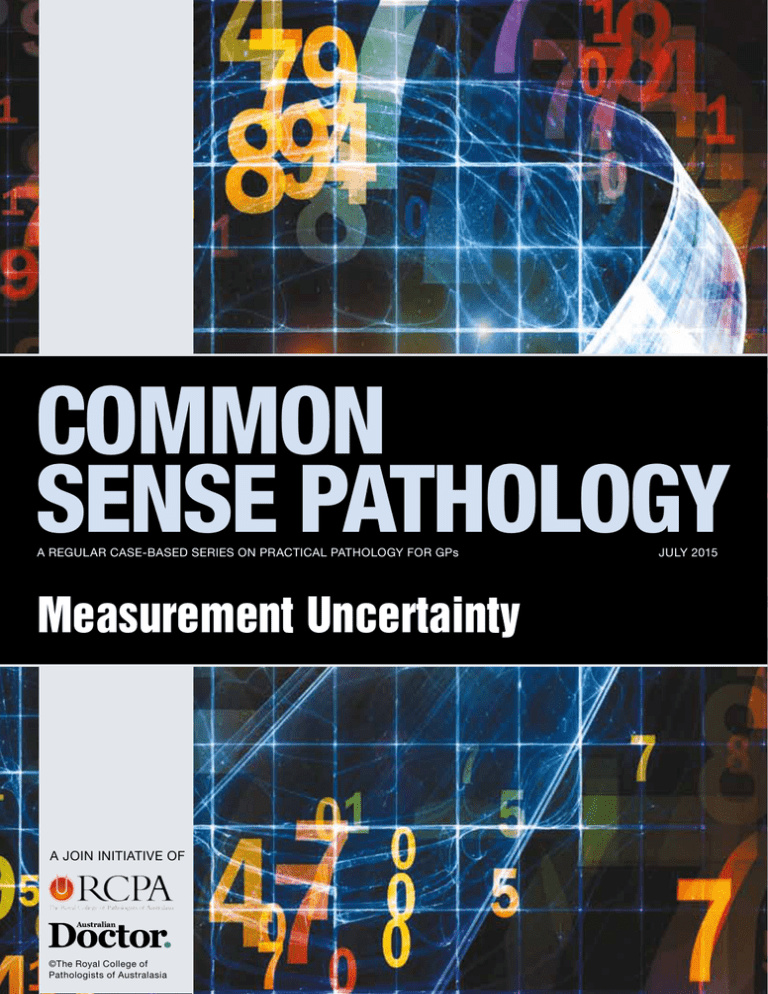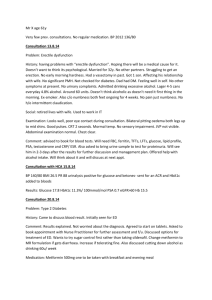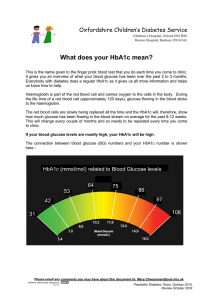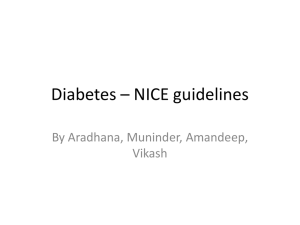Common SenSe Pathology
advertisement

Common Sense Pathology A REGULAR CASE-BASED SERIES ON PRACTICAL PATHOLOGY FOR GPs Measurement Uncertainty A JOIN INITIATIVE OF ©The Royal College of Pathologists of Australasia JULY 2015 This issue of Common Sense Pathology is a joint initiative of Australian Doctor and the Royal College of Pathologists of Australasia. Published by Cirrus Media Tower 2, 475 Victoria Ave, Locked Bag 2999 Chatswood DC NSW 2067. Ph: (02) 8484 0888 Fax: (02) 8484 8000 E-mail: mail@australiandoctor.com.au Website: www.australiandoctor.com.au (Inc. in NSW) ACN 000 146 921 ABN 47 000 146 921 ISSN 1039-7116 © 2014 by the Royal College of Pathologists of Australasia www.rcpa.edu.au CEO Dr Debra Graves Email: debrag@rcpa.edu.au While the views expressed are those of the authors, modified by expert reviewers, they are not necessarily held by the College. Common Sense Pathology Editor: Dr Steve Flecknoe-Brown Email: sflecknoebrown@gmail.com Australian Doctor Education Director: Dr Amy Kavka Email: amy.kavka@cirrusmedia.com.au Reviewer: Dr Amanda McBride Email: amanda.mcbride@cirrusmedia.com.au Chief Content Producer: Cheree Corbin Email: cheree.corbin@cirrusmedia.com.au Graphic designer: Edison Bartolome Email: edison.bartolome@cirrusmedia.com.au Production co-ordinator: Eve Allen Email: eve.allen@cirrusmedia.com.au For an electronic version of this and previous articles, you can visit www.australiandoctor.com.au or download an ebook version from www.australiandoctor.com. au/ebooks You can also visit the Royal College of Pathologists of Australasia’s web site at www.rcpa.edu.au Click on Library and Publications, then Common Sense Pathology. This publication is supported by financial assistance from the Australian Federal Department of Health. 2 AUTHORS Associate Professor Tony Badrick RCPA Quality Assurance Programs, Sydney, NSW. Associate Professor Peter Stewart Sydney South West Pathology Service, Royal Prince Alfred Hospital, Sydney, NSW. Understanding measurement uncertainty ANY measurement has some error associated with the process itself. For example, measuring weight is affected by the accuracy of the scales, what the patient is wearing, if the patient moves and the parallax error of the scale reader. Understanding this measurement uncertainty assists in interpreting this result, and understanding if there is a real difference between this and a future result. Technically, uncertainty means doubt about accuracy of a measurement. The commonly used term used to describe this concept is measurement uncertainty (MU) and characterises the dispersion of results about a single measurement. Medical pathology laboratories are required as part of their accreditation to determine or estimate the MU for all quantitative results. “ Medical pathology laboratories are required to determine or estimate the measurement uncertainty for all quantitative results. Estimating MU in a laboratory environment is a fourstep process involving the following: 1. Define what will be measured. 2. Identify all sources of uncertainty. 3. Q uantify the uncertainties of each of these sources. 4. C alculate the combined uncertainty. The measurement of HbA1c is an important marker for diagnosis and control of diabetes. An ideal primary goal of diabetes therapy is an HbA1c level of less than 6.5% (48mmol/mol), although this does vary depending on the individual patient’s treatment plan. The non-diabetic reference range is generally accepted as 4.0-6.0% (20mmol/mol-42mmol/mol). Note HbA1c results must only apply to assay methods that are traceable to the Diabetes Control and Complications Trial reference procedure, to ensure that the conclusions of the study and decision points are applicable for interpreting patient HbA1c values. To provide a clear analytical distinction between the recommended HbA1c concentrations, an analytical (method) uncertainty expressed statistically as a coefficient of variation (CV) of less than 3% is required. Methods that produce analytical CVs of 4.0% or greater are not considered fit for purpose, as this degree of analytical imprecision cannot distinguish changes in the HbA1c level of 1%, that is, cannot distinguish a HbA1c level of 7.0% (53mmol/mol) from 8.0% (64mmol/mol). When the analytical CV (uncertainty of measurement) is applied to the actual measured HbA1c value, the possible range of HbA1c values applicable to this measurement can be determined. (It is usual practice to calculate the 95% confidence interval for pathology measurements, calculated as 1.96 standard deviations or 1.96 coefficients of variation about the measured value.) For example, if the analytical CV is 3%, a measured HbA1c can only be regarded as falling within a range of values defined by ± twice the CV; in this example it is ± 6% of the measured value. Examples for a nominal analytical CV of 3% at various measured HbA1c levels are shown in the table on the next page. 3 ANALYTICAL CV of 3% for HBA1C MEASUREMENTS Measured HbA1C% (mmol/mol) Uncertainty of measurement range for an analytical CV of 3% 5.0 (31) 4.7–5.3 (28-34) 6.0 (42) 5.6–6.4 (38-46) 6.5 (48) 6.1–6.9 (43-52) 7.0 (53) 6.6–7.4 (49-57) 7.5 (58) 7.1–8.0 (54-64) 8.0 (64) 7.5–8.5 (58-69) 8.5 (69) 8.0–9.0 (64-75) 9.0 (75) 8.5–9.5 (69-80) 10.0 (86) 9.4–10.6 (79-92) CASE studY rs A is 48 and had diabetes diagnosed M four years previously and is on oral hypoglycaemic treatment. Her GP monitors control with three-monthly HbA1c measurements. Three previous readings are 6.6, 7and 7.4 % (49, 53 and 57mmol/mol). Question: The GP is concerned that her control is deteriorating. Is that correct? Answer: Not necessarily. All these results are within the same MU, and cannot be distinguished from each other. Sources of variation in results Sources of uncertainty in laboratory measurements include: • Non-representative sampling. • Environmental effects on the measurement process (for example, heat and light). • Personal reading errors. • Finite instrument resolution of discrimination thresholds. • Inexact values of measurement standards. • Approximations incorporated into the measurement. 4 • Variations in reported observations under apparently identical conditions. All together these different effects can be classified as either imprecision, bias, calibration or others. A number of these sources of uncertainty are difficult to quantify. The laboratory will limit the uncertainty calculation to the analytical process. The GP needs to call the pathology laboratory to ascertain the most correct levels, or variability status, so that the GP can understand the patient’s situation. For any test, there are a number of causes of variation. If we take glucose as an example, there are various disease states that will elevate glucose concentrations, including diabetes mellitus caused by deficient or ineffective insulin; or decrease glucose concentrations, such as excessive insulin levels in insulinoma. Other endocrine disease will also increase glucose levels “ The GP needs to call the pathology laboratory to ascertain the most correct levels, or variability status, so that the GP can understand the patient’s situation. because of the antagonistic effects of some hormones on insulin action. However, there are many other non-pathological factors that affect glucose levels, leading to apparent elevations or decreases in glucose levels. These are grouped into biological variation, pre-analytical or analytical variation. This non-pathological variation can be characterised for all tests, and allows an understanding of the causes of variation and possible means of minimising the source, and hence better interpretation by the clinician. Biological variation is due to normal physiological rhythms such as: • Daily patterns of sleep and wake. • Food and water intake and exercise. • Monthly hormonal changes in the menstrual cycle, during menopause or in pregnancy. • Seasonal variations (eg, temperature and sunlight). • The effects of the ageing process. Biological variation is different from the concept of a normal or reference interval. There is a normal biological variation of an individual as well as the biological variation of a population at a particular season and place. Pre-analytical variation in test results is related to the preparation of the patient and the treatment of the sample. The test result depends on the time the sample is taken, how it is taken and how the sample is preserved. For serum glucose levels to reflect the normal state of the patient, the sample must be a fasting sample, taken without any collection problems, and any cellular impacts on the sample glucose levels must 5 be controlled. It should be a freely flowing sample (without stasis, not from an arm with a drip, and not from sample contaminated by tissue fluid as can happen with a finger prick), collected into the correct container with the appropriate preservative, and transported promptly to the laboratory. Analytical sources of error are those where the assay is not calibrated correctly, or where there are random sources of error because of reagent deterioration or poor instrument maintenance. The total physiological variation is the sum of the individual, population and analytical variation. Calculating measurement uncertainty Laboratories routinely determine if an analysis has been acceptable by comparing the results of known quality control (QC) samples against predetermined values. These QC samples are purchased in large volumes, often sufficient for the laboratory for two or more years. Thus laboratories quickly accumulate a lot of data on replicate samples for every assay they perform. These data are the basis for determining MU and is expressed as the standard deviation or coefficient of variation. These QC sample concentrations are ideally chosen to reflect critical clinical decision points for the assays (eg, HbA1c close to 6.5% [48mmol/mol]). Uses of measurement uncertainty The main clinical applications of MU are listed below: 1. Appropriateness for use Tests are used to identify diseases where the test result is above or below ‘normal’ levels. For a test to be able to discriminate between healthy state and disease state, the assay must be able to measure concentrations within the normal range. As every measurement has an MU associated with it, the MU must be less than the normal range if the test is to be able to measure differences from the normal. To measure changes within the normal range, the MU must be less that the biological variation, ideally less than a quarter of that. Laboratories are required by the accreditation 6 authority to have determined the MU for each quantitative assay and to assess the appropriateness for use of those assays. All assays used routinely are fit for this purpose. With some tests, the analytical variation is high compared with the biological variation; hence great care is needed to ensure the assay does indeed discriminate between normal and pathological levels. 2. Diagnosis Pathology test results can be interpreted in three ways: against a reference interval (the proper term for “normal range”), against a decision level or against previous results. Some tests are interpreted against a decision level, such as glucose in a glucose tolerance test, cholesterol levels and HbA1c measurements. In the case of HbA1c, a level of 48mmol/mol(6.5%) is a critical clinical “ A decision level needs to be cautiously interpreted with the knowledge that the cut off has an associated measurement error. decision level in terms of diabetes diagnosis. But as discussed above, the MU of HbA1c at the level of 48mmol/mol is +/- 4mmol/mol. Therefore a decision level needs to be cautiously interpreted with the knowledge that the cut off has an associated measurement error. For this reason, it is good practice to repeat these measurements at a different time before a diagnosis is made and management is changed. Monitoring a patient involves comparing a test result against a previous result to determine if treatment or compliance is successful. To be sure that two results used to monitor the patient are different requires an understanding of biological variation and MU. For example, HbA1c results that differ by less than the MU are not different, so consecutive results of 47, 49 and 51mmol/mol are all the same within the error of the method. 3. Quality control in the laboratory MU is used when assessing the quality control rules and rigor required keeping an assay performance acceptable. An assay that has a high MU requires more vigilance than one with low variation. CASE studies r P is a 56-year-old man who has been M having serum PSA measurements annually by his GP. Mr P has a PSA result of 4.2µg/L; 12 months ago, the result by the same laboratory and measurement procedure was 3.8µg/L. (Reference Range <3.8ug/L in the laboratory) Question: Considering only the measurement uncertainty, has the PSA increased? 7 Answer: When the laboratory was asked, they provided the MU for PSA at a concentration of 2.9µg/L to be 0.15µg/L (uncertainty = 5.0%). The PSA has increased from 3.8 to 4.2. This is 0.4/3.8 x 100 = 10.5% So, is the PSA increase greater than the laboratory would expect from the measurement imprecision? Laboratories can calculate what an expected difference in two results measured at different times should be, based only on the MU of the method. This is achieved using a statistical formula expressed as 2.77 x SD of the method. For the above example: 2.77 x 5.0% = 14%, namely the two results should differ by >14% (>0.53µg/L) for there to be 95% confidence that they are in fact different. In this case, the laboratory has used its MU data in several ways to assist the referring practitioner with an interpretative comment, ‘Taking account of measurement variability, this result is not significantly different at a confidence level of 95%’. Question: Is the latest PSA value significantly above the 8 age-related clinical decision value of 4.0µg/L? Answer: The clinical decision value of 4.0µg/L does not have a known uncertainty associated with it. The MU of the result of 5.0% = 0.21µg/L at a level of 4.2µg/L. The lab can assist with calculating the confidence interval for the patient result, which was found to be +/- 0.4µg/L. Thus the 95% confidence interval for the latest result = 3.8-4.4µg/L. So the result is not significantly different to 4.0 µg/L. These examples demonstrate the importance of understanding the information that MU can provide to assist clinical decisions. Advice on the interpretation of results can always be sought from the providing laboratory. In particular, the laboratory would be able to help with any calculations for statistical validation and always welcomes such enquiries. References Clinical Biochemist Review 2004; 25(4):S1–S24.






